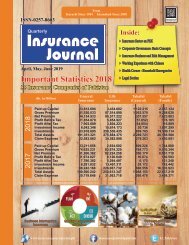Create successful ePaper yourself
Turn your PDF publications into a flip-book with our unique Google optimized e-Paper software.
Guest Contribution
Doctrine of
Co-Insurance
Qayyum Pervez Malik
Insurance Surveyor & Loss Adjuster /
Claims Investigator
Qayyum Pervez Malik & Co. (Pvt) Ltd
Depending upon the magnitude,
nature, type, class and demand of
insured (Mortgagors/Mortgages) each
and every risk is insured by following
the under mentioned procedure and
practice.
a. Risk to be underwritten by single
independent Insurer.
b. Risk to be underwritten by multiple
co-insurers independently.
c. Risk to be underwritten by multiple
co-insurers collectively.
The principal of contribution as laid
down in the Insurance policy as well as
in co-insurance clause which is
attached with the insurance policies at
the time of underwriting a risk.
As per the principal of contribution the
contribution condition stipulates that
“at the time of any destruction of or
damage to any property hereby insured
there be any other insurances effected
by or on behalf of the insured covering
any of the property destroyed or
damaged, the liability of the company
hereunder shall be limited to its ratable
proportion of such destruction or
damage.”
Such right of an insurer is already
exists in common law and the principal
of indemnity. Co-Insurance clause as
attached with the insurance policy in
case the risk is insured by multiple
insurers, also set up lines for this
procedure.
In case of high magnitude risks, the
insured tends to be underwritten by
more than one insurer setting up the
percentage of coverage to be allocated
to each of the participating insurers out
of which the highest risk taker is given
the status of a “Leader” who is
responsible to issue a schedule
insurance policy collectively as signed
by all the co-insurers in order to share
the risk among more than one insurers
for financial security of the insured and
to save the wastage of time by
interacting with multiple insurers by
issuing separate insurance policies etc.,
This arrangement provides the
concurrence of all the insuring factors
on which the collective policy is
drafted which eradicate the turbulence
of non-concurrence of terms of
different contracts of insurance in case
the risk is covered separately by
m u l t i p l e i n s u r e r s . U n d e r t h e
c i r c u m s t a n c e s t h e “ s c h e d u l e
insurance” of risks underwritten by
multiple insurers collectively by
signing a single insurance policy is the
best insurance arrangement any
insured could have.
In above arrangement of insurance, the
terms of contract, warranties,
conditions, clauses etc. are discussed
and finalized with the leading insurer
who then takes the coinsurers on board.
The proportion of risk to be allocated to
each of the insurer is decided by the
insured. Currently the premium is paid
to each and every co-insurers through
cheques separately. In case of any
loss/damage to the insured's property
the intimation of claim is served to the
leader who then intimate the same to
the co-insurers. As per prevailing
practice, the surveyor is appointed by
the leader with intimation to the coinsurers.
Thereafter all the subsequent
proceedings, assessment of loss,
survey report along with all the
relevant documentary evidence are
properly and promptly shared with the
co-insurers. The payment of claim so
adjusted is also made by each of the coinsurer
separately.
At times, each and every co-insurer
used to appoint their independent
surveyor to assess the loss along with
the surveyor appointed by the leader
but later, this practice was discontinued
mostly and the surveyor is appointed
by the leader.
Surveyor so appointed by the leader
remain in touch with all the coinsurers/leader
in order to provide the
necessary update of the claim. The
leader is also bound to pass on and
provide each and every material fact,
documentary evidence, update to the
co-insurers. As per practice, the leader
is also bound to share the intimation of
loss as received from the insured with
the co-insurers in time as stipulated in
the contract of insurance. So, the
impact/effect of late sharing of claim
intimation, late sharing of relevant
claim documents etc. shall be borne by
the leader. Since the co-insurers follow
the assessment of surveyor as
appointed by the leader so it is the
responsibility of the surveyor so
appointed and the leader to keep the co-
Insurance Journal October, November, December 2021
15
Find us at: www.insurancejournal.com.pk — www.facebook.com/insurancejournalpakistan

















